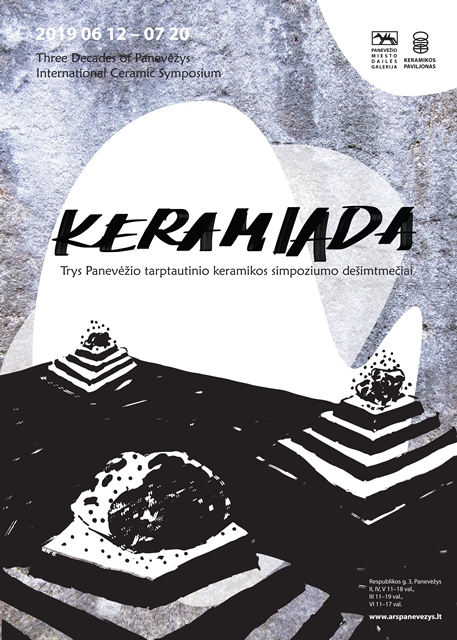2019 – anniversary year of Panevėžys International Ceramic Symposium. Just three decades ago, in 1989, on the initiative of young students and graduates of Vilnius Art Institute (VDI, now – Vilnius Academy of Arts), the first symposium was organized with the participation of 16 artists of various branches of art. The first international ceramics event in Panevėžys was quite different from the current symposiums, but it was characterized by briskness, youthful energy, and intense creative mood.
The first steps towards an international ceramics symposium began in 1977, when Alvydas Pakarklis, the student of Vilnius Art Institute, started working at Panevėžys Glass Factory. His interest in the refractory stone mass used in the glass industry led him to experiment with this material. The creative process was blessed and supported by the glass factory management, and especially by Stasys Stoškus, who was the then director of this factory. In 1983, students of Vilnius Art Institute led by Juozas Adamonis (who also participated in the symposium in 1999), the professor, came to the factory for creative practice, and since 1984 the creative workshops of Lithuanian ceramicists have been started in this factory. All this time, artists used a high-efficient combustion of gas-fired kiln for their work, with temperatures up to 1380 ° C. The exceptional size of the kiln (h – 1.80 cm, area – 12 m², volume – 20 m3) allowed to create impressive scale works.
In 1989, Tomas Daunora, Arūnas Rutkus, and Rimantas Skuodis, the students of Vilnius Art Institute, organized the First International Symposium. They invited Philip Cornelius (1934–2015) from the USA, Rimas VisGirda, who is the American Lithuanian, and Katalin Högye from Hungary. They were accompanied by a group of Lithuanians: Romualdas Aleliūnas (1960–2016), Valdas Aničas, Vilija Balčiūnienė, Eugenijus Čibinskas, Nerutė Čiukšienė, Alfridas Pajuodis, Egidijus Radvenskas, Aldona Skudraitė, Gintautas Šveikauskas, and Vytautas Tallat-Kelpša. The creative process took place at the School of Children’s Art (former church premises), combustion took place at the Glass Factory, and the exhibition of works created was presented at the Panevėžys Drama Theater (now – Juozas Miltinis Drama Theater). The first symposium was experimental and laid a strong foundation for the future creative process.
Since 1990, the symposiums have been organized by Panevėžys Civic Art Gallery. Until 2016, it was taken care of by Jolanta Lebednykienė, who was the then gallery director. In her efforts, 20 symposiums have been held, which can be boldly identified as an important cultural phenomenon in Lithuanian art history. In the creative process, chamotte clay is used. This clay is often referred to as the stone mass of Panevėžys by art historians, which shows the importance and position of this event. During the three decades, 21 symposiums have taken place (Symposiums were held annually at the Glass Factory. Since 2004 – every two years. Since 2006, symposiums were held at ceramics company „Midenė”). As it is known, 163 artists from 35 countries took part. The collection contains over 600 works and compositions. This type of contemporary ceramics collection is the only one in Eastern Europe, and in Lithuania it is the only permanent exposition of contemporary ceramics.
At the exhibition “KERAMIADA. Three decades of Panevėžys International Ceramic Symposium” 21 works of author are presented. Symbolically one piece from each year is taken. Typically, works of these symposiums are identified with large scales. In this case, attention is focused on smaller forms, but at artistic level they are not inferior to larger works. In order to commemorate the anniversary year, the works are symbolically displayed like on the stairs. At this point, where the ceramic pavilion is now, in 2014 there still was a stepped structure that resembled a mini amphitheater. It was a gathering place. In this place the participants of the symposiums performed demonstrations of their individual techniques, the spectators sat around, they communicated and shared ideas together. The exhibits are now communicating with the audience, presenting themselves and presenting the history of this impressive pottery “laboratory” of three decades.
The exposition is complemented by the pictures of 1989 created by photographer Sergejus Kašinas, which became not only documentary material of this event, but also separate works. These pictures captured moments of work, excursions, and other important events. This year also marks the 30th anniversary of the Baltic Way. Participants of the first symposium also stood in a lively chain of people. This moment was captured in Tomas Daunora’s photograph.
The tradition of Panevėžys international ceramics symposiums is significant in many aspects. At the beginning of the event, it was an exceptional opportunity for Lithuanian ceramicists to get acquainted with the traditions and viewpoints of other countries. Now we can say that the symposiums have entered the history of Lithuanian art. They developed a creative personality of more than one ceramicists, provided knowledge and opportunities, and encouraged their development.
The authors: Rimas VisGirda, Peteris Martinsons, Thomas Orr, Jonas Arčikauskas, Eugenijus Čibinskas, Kieran Behan, Daniela Chinellato, Mel Mars, Michael Moore, Maria Baumgartner, David Alban, David L. Gamble, Hwang Jeng-Daw, Jovita Laurušaitė, Toghrul Dadashov, Billy Ray Mangham, Edita Rydhag, Ihor Bereza, Tamara Bereza, Heidi Preuss Grew, Nataliya Zuban.
June 12, 2019 – July 20
Exhibited at Ceramic Art Pavilion


